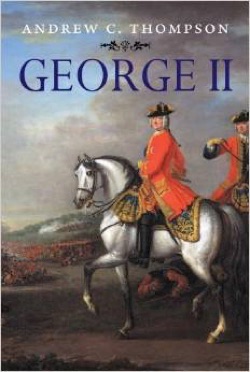George II (2011)
Book Number: 25
Published as ‘George II: King and Elector’ in hardback by Yale in 2011 (April in the UK and June in the USA). The paperback followed in 2013. According to the series list on the rear cover of Michael Prestwich’s 1988 biography of Edward I this book was originally to be written by Dr. Aubrey Newman (1927- ) of the University of Leicester. The subtitle must deliberately have been chosen to mirror that of the George I book - from Elector and King to King and Elector - to indicate that the Hanoverians had graduated from being German princes to British kings. In his Preface and Acknowledgements page the author thanks Robert Baldock and the team at Yale for giving him "...the opportunity to undertake this project in the first place", indicating that this book was commissioned by Yale and not Methuen. By now, the new English Monarchs Series books are well into the Yale period with few remaining books yet to be published from the earlier commission by Methuen, notably Edward III (published in 2011) and Henry III (published in 2020).
At the beginning of his introduction, Dr. Thompson alerts the reader that George II is something of a forgotten king, save for the facts that he was the last foreign-born king and the last to lead an army into battle. He describes the paucity of documentary evidence surviving from his life, compounded by his lack of personal record keeping. Moreover, much of the Hanoverian archives remained in Germany and became the victim of war and natural disaster. Thompson’s task was similar to that of a biographer of a medieval king, whose challenge is to piece together what can be found and analyse the evidence. Dr. Thompson also explains that his task was in part that of rescuing George II after being marginalised through the “...grand narrative of Whig history” in which the march of progress saw parliament ascendent and the monarch in decline.
Dr Clarissa Campbell Orr (Anglia Ruskin University) on the Reviews in History website (at this link) comments that "Thompson’s penetrating and detailed biography puts the central figure of the reign back into play, and greatly clarifies and enriches our understanding of these vital 33 years” and that "The biography shows George as a dynastic ruler...who had diverse territories to govern”. She comments that “Thompson is sceptical about how far George was dominated by his ministers” and examines the relationship George had with his cabinet, which provides “...not only a revised view of who held the balance of power, but a fresh look at ministers who have received less attention."
Michael Schaich, reviewing the book in The Scriblerian and the Kit-Cats, Volume 46 no. 2, 2014, said "Thompson’s judicious and extensively researched account based on sources in British as well as German archives. It is now difficult to see how a more rounded treatment can be achieved”.
Robin Eages (of The History of Parliament project) in History, Volume 97 Number 325 (2012) made a criticism of the book suggesting a lack of understanding of the nature of English Monarchs titles: "...at times this reads less of the king and more like a study of the period during which he reigned." Books in the series tend to be political histories, not just a study of the central figure. Despite that dissatisfaction, Eagles concluded "...This is an impressive piece of research. The nature of his papers (or rather the lack of them) means George II is always going to remain partly obscured by shadow. That Thompson has managed to draw him so much further into the light with a scholarly and yet very readable treatment is something for which he is to be much commended."
Again, an English Monarch series book takes the reader on a journey of discovery, breaking new ground in historical research. The study of a lesser remembered king provides one of the great surprises in the series.
Yale, 2011 and 2013

Cover: The image of George shows him at the Battle of Dettingen by John Wooton and owned by the National Army Museum, London.
Email for Comments | Sitemap | Main Book Page | Saxon/Pre-Normans | Normans | Angevins | Plantagenets | Tudors | Stuarts | Georgians
Further reading
It is often forgotten that the successor to George II was not his son, but his grandson. George III was the son of Frederick, Prince of Wales who has largely been overlooked by biographers. One worthy, although old, biography exists which will embellish the Hanoverian story between Georges II and III: 'The Royal Griffin: Frederick, Prince of Wales, 1707-51' by John Walters was published in 1972 by Jarrold Publishing, ISBN 9780091112400
George II: King and Elector
By Dr. Andrew C. Thompson
Official Fellow and College Lecturer in History,
Queens College, University of Cambridge
Book Editor: Robert Baldock